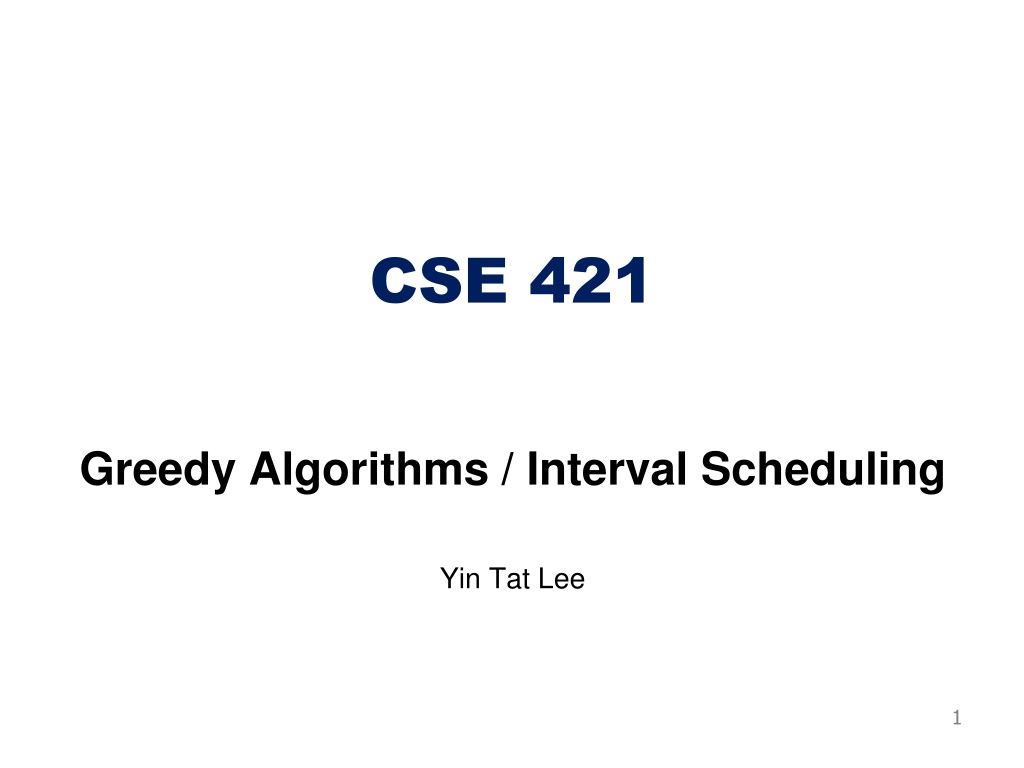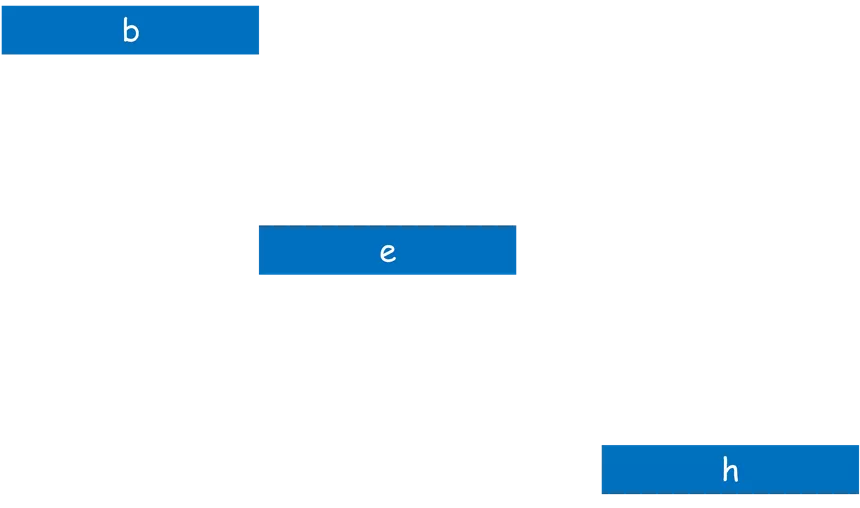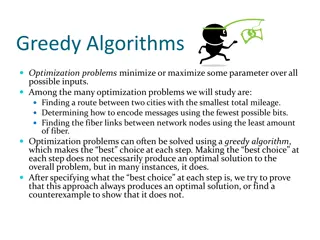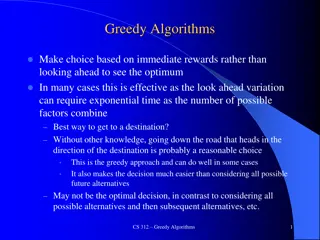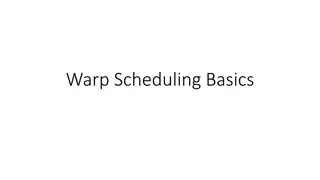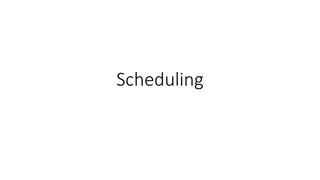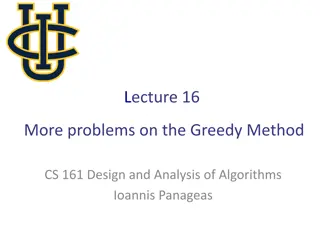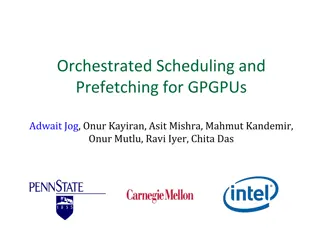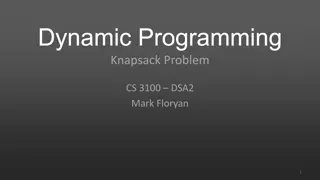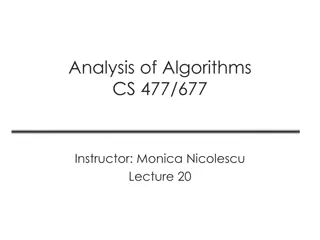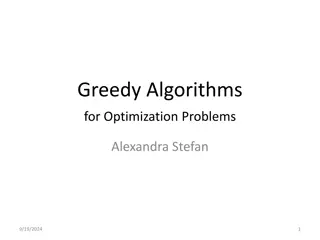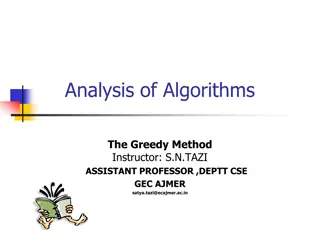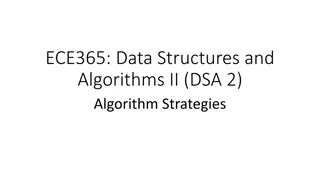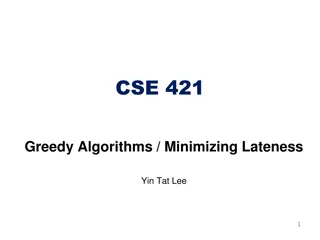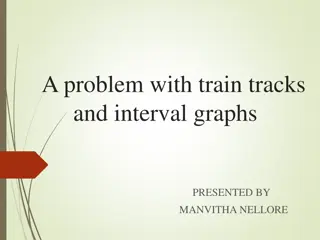Interval Scheduling and Greedy Algorithms
Explore the concepts of interval scheduling, job compatibility, greedy algorithms, and interval partitioning as discussed by Yin Tat Lee in CSE 421. Understand the application of earliest finish time strategy in scheduling jobs and the optimal nature of greedy algorithms. Discover how to find the maximum subset of mutually compatible jobs and the minimum number of classrooms needed for scheduling lectures without overlaps.
Download Presentation

Please find below an Image/Link to download the presentation.
The content on the website is provided AS IS for your information and personal use only. It may not be sold, licensed, or shared on other websites without obtaining consent from the author.If you encounter any issues during the download, it is possible that the publisher has removed the file from their server.
You are allowed to download the files provided on this website for personal or commercial use, subject to the condition that they are used lawfully. All files are the property of their respective owners.
The content on the website is provided AS IS for your information and personal use only. It may not be sold, licensed, or shared on other websites without obtaining consent from the author.
E N D
Presentation Transcript
CSE 421 Greedy Algorithms / Interval Scheduling Yin Tat Lee 1
Interval Scheduling Job ? starts at ?(?) and finishes at ?(?). Two jobs compatible if they don t overlap. Goal: find maximum subset of mutually compatible jobs. a b b c d e e f g h h Time 0 1 2 3 4 5 6 7 8 9 10 11 2
Greedy Alg: Earliest Finish Time Consider jobs in increasing order of finish time. Take each job provided it s compatible with the ones already taken. Sort jobs by finish times so that f(1) f(2) ... f(n). ? for j = 1 to n { if (job j compatible with ?) ? ? {?} } return ? Implementation. ?(?log?). Remember job ? that was added last to ?. Job ? is compatible with ? if ? ? ?(? ). 3
Correctness Theorem: Greedy algorithm is optimal. Proof: (technique: Greedy stays ahead ) Let ?1,?2,?3, ,?? be jobs picked by greedy, ?1,?2,?3, ,?? those in some optimal solution in order. We show ?(??) ?(??)for all ?, by induction on ?. Base Case: ?1 chosen to have min finish time, so ?(?1) ?(?1). IH: ?(??) ? ??for some r IS: Since ? ?? ? ?? ?(??+1), ??+1 is among the candidates considered by greedy when it picked ??+1, & it picks min finish, so ? ??+1 ?(??+1) Observe that we must have ? ?, else ??+1 is among (nonempty) set of candidates for ??+1. 4
CSE 421 Greedy Algorithms / Interval Partitioning Yin Tat Lee 5
Interval Partitioning Lecture ? starts at ?(?) and finishes at ?(?). Goal: find minimum number of classrooms to schedule all lectures so that no two occur at the same time in the same room. e Room 4 j Room 3 g c d Room 2 b h Room 1 a f i 3 3:30 4 4:30 9 9:30 10 10:30 11 11:30 12 12:30 1 1:30 2 2:30 Time 6
Interval Partitioning Note: graph coloring is hard in general, but graphs corresponding to interval intersections are simpler. E J Room 4 D G C Room 3 H Room 2 B I F Room 1 A e j g c d b h a f i 3 3:30 4 4:30 9 9:30 10 10:30 11 11:30 12 12:30 1 1:30 2 2:30 Time 7
A Better Schedule This one uses only 3 classrooms f c d j i b g a h e 3 3:30 4 4:30 9 9:30 10 10:30 11 11:30 12 12:30 1 1:30 2 2:30 Time 8
A Greedy Algorithm Greedy algorithm: Consider lectures in increasing order of finish time: assign lecture to any compatible classroom. Sort intervals by finish time so that f1 f2 ... fn. d 0 for j = 1 to n { if (lect j is compatible with some classroom k, ? ? ?) schedule lecture j in classroom k else allocate a new classroom d + 1 schedule lecture j in classroom d + 1 d d + 1 } Correctness: This is wrong! 9
Example a In the interval scheduling problem, we want to ignore super long job. b c In this problem, we need to schedule all the jobs. Picking them tightly is important. d Time 0 1 2 3 4 5 6 OPT: Greedy by finish time gives: a d c a c b b d Time Time 0 1 2 3 4 5 6 0 1 2 3 4 5 6 10
A Greedy Algorithm Greedy algorithm: Consider lectures in increasing order of start time: assign lecture to any compatible classroom. Sort intervals by starting time so that s1 s2 ... sn. d 0 for j = 1 to n { if (lect j is compatible with some classroom k, ? ? ?) schedule lecture j in classroom k else allocate a new classroom d + 1 schedule lecture j in classroom d + 1 d d + 1 } Implementation: Exercise! 11
A Structural Lower-Bound on OPT Def. The depth of a set of open intervals is the maximum number that contains any given time. Key observation. Number of classrooms needed depth. Ex: Depth of schedule below = 3 schedule below is optimal. Q. Does there always exist a schedule equal to depth of intervals? f c d j i b g a h e 3 3:30 4 4:30 9 9:30 10 10:30 11 11:30 12 12:30 1 1:30 2 2:30 Time 12
Correctness Theorem: Greedy algorithm is optimal. Proof (exploit structural property). Let ? = # classrooms greedy allocates. Classroom ? is opened because there are ? 1 classrooms are in use. So, ? lectures overlapping at time ? ? , i.e. depth ?. So, all schedules use d classrooms, So, greedy is optimal 13
CSE 421 Greedy Algorithms / Minimizing Lateness Yin Tat Lee 14
Scheduling to Minimizing Lateness Similar to interval scheduling. Instead of start and finish times, request ? has Time Requirement ??which must be scheduled in a contiguous block Deadline ?? by which time the request would like to be finished Requests are scheduled into time intervals [??,??] s.t. ??= ?? ??. Lateness for request ? is If ??< ??then request ? is late by??= ?? ??otherwise its lateness ??= ? Goal: Find a schedule that minimize the Maximum lateness ? = ??? ? lateness = 2 1 2 3 4 5 6 3 2 1 4 3 2 ?? 6 8 9 9 14 15 ?? ?? lateness = 0 max lateness = 6 d3 = 9 d2 = 8 d6 = 15 d1 = 6 d5 = 14 d4 = 9 12 13 14 15 0 1 2 3 4 5 6 7 8 9 10 11
Minimizing Lateness: Greedy Algorithms Greedy template. Consider jobs in some order. [Shortest processing time first] Consider jobs in ascending order of processing time ??. 1 2 tj 1 10 dj 100 10 [Smallest slack] Consider jobs in ascending order of slack ?? ??. counterexample 1 2 1 10 tj dj 2 10 counterexample [Earliest deadline first] Consider jobs in ascending order of deadline ??. 16
Greedy Algorithm: Earliest Deadline First Sort deadlines in increasing order (?? ?? ??) ? ? for ? ? to ? to ?? ? ?? ??+ ?? ? ?? end for 1 2 3 4 5 6 3 2 1 4 3 2 ?? 6 8 9 9 14 15 ?? max lateness = 1 d1 = 6 d2 = 8 d3 = 9 d4 = 9 d5 = 14 d6 = 15 12 13 14 15 0 1 2 3 4 5 6 7 8 9 10 11 17
Minimizing Lateness: No Idle Time Observation. There exists an optimal schedule with no idle time. d = 4 d = 6 d = 12 0 1 2 3 4 5 6 7 8 9 10 11 d = 4 d = 6 d = 12 0 1 2 3 4 5 6 7 8 9 10 11 Observation. The greedy schedule has no idle time. 18
Proof for Greedy Algorithm: Exchange Argument We will show that if there is another schedule ? (think optimal schedule) then we can gradually change ? so that at each step the maximum lateness in ? never gets worse. it eventually becomes the same cost as ?. 19
Minimizing Lateness: Inversions Definition An adjacent inversion in schedule ? is a pair of jobs? and ? such that ??< ?? Job ? is scheduled immediately after Job ? inversion j i before swap Observation Greedy schedule has no adjacent inversions. 20
Minimizing Lateness: Inversions Definition An adjacent inversion in schedule ? is a pair of jobs? and ? such that ??< ?? Job ? is scheduled immediately after Job ? inversion ?? j i before swap i j after swap ?? Claim Swapping two adjacent, inverted jobs reduces the number of inversions by one and does not increase the max lateness. 21
Minimizing Lateness: Inversions Lemma: Swapping two adjacent, inverted jobs does not increase the maximum lateness. inversion ?? j i before swap i j after swap ?? Proof: Let ? be the schedule after swapping. Lateness ?? ??since ? is scheduled earlier in ? than in ? Requests ? and ? together occupy the same total time slot in both schedules All other requests ? ?,? have ?? = ?? ?? = ??so ?? Maximum lateness has not increased! = ?? ??= ?? ??< ?? ??= ?? 22
Optimal schedules and inversions Claim: There is an optimal schedule with no idle time and no inversions Proof: By previous argument there is an optimal schedule ? with no idle time If ? has an inversion then it has a consecutive pair of requests in its schedule that are inverted and can be swapped without increasing lateness Eventually these swaps will produce an optimal schedule with no inversions Each swap decreases the number of inversions by 1 There are at most ?(? ?)/? inversions. (we only care that this is finite.) 14
Idleness and Inversions are the only issue Claim: All schedules with no inversions and no idle time have the same maximum lateness Proof: Schedules can differ only in how they order requests with equal deadlines Consider all requests having some common deadline ? Maximum lateness of these jobs is based only on the finish time of the last of these jobs but the set of these requests occupies the same time segment in both schedules Last of these requests finishes at the same time in any such schedule. 24
